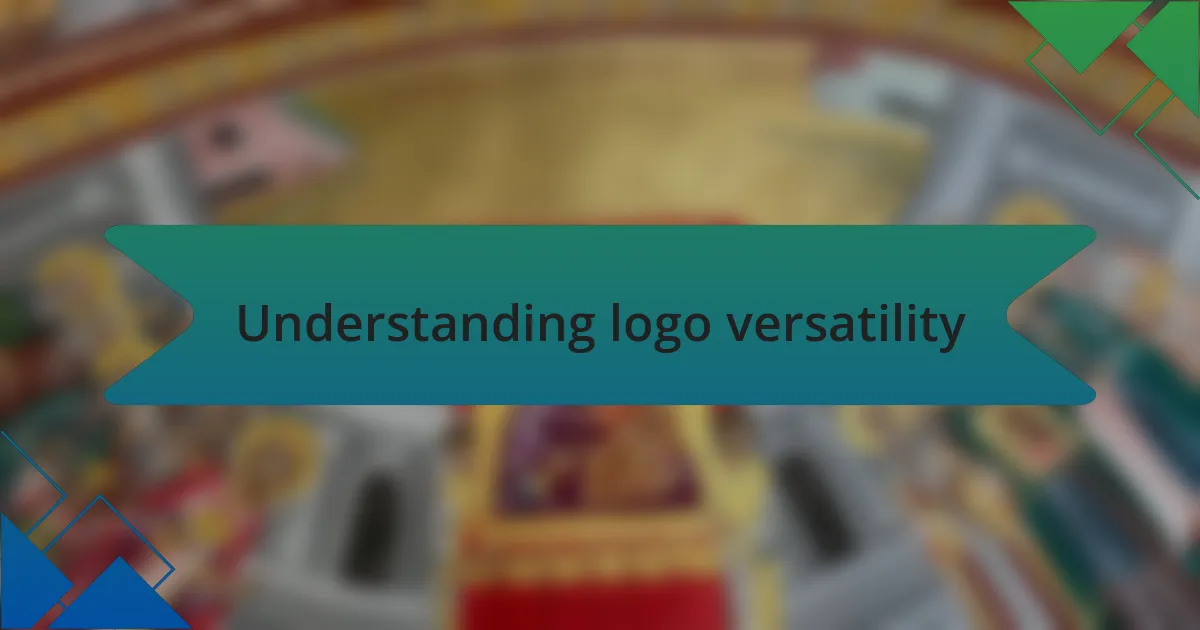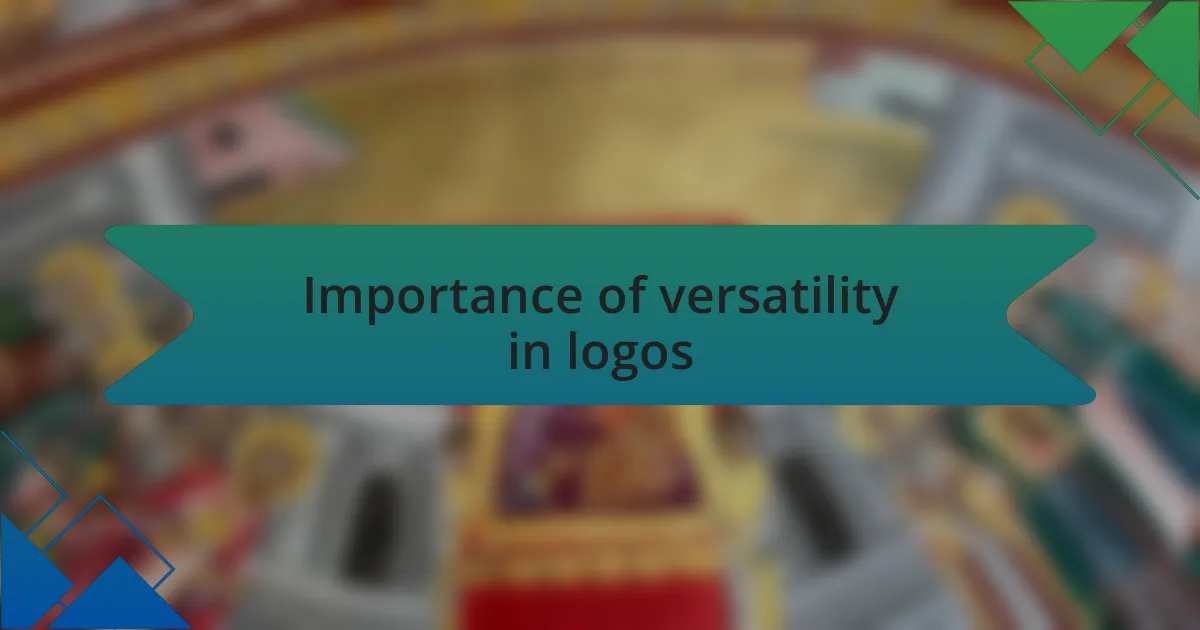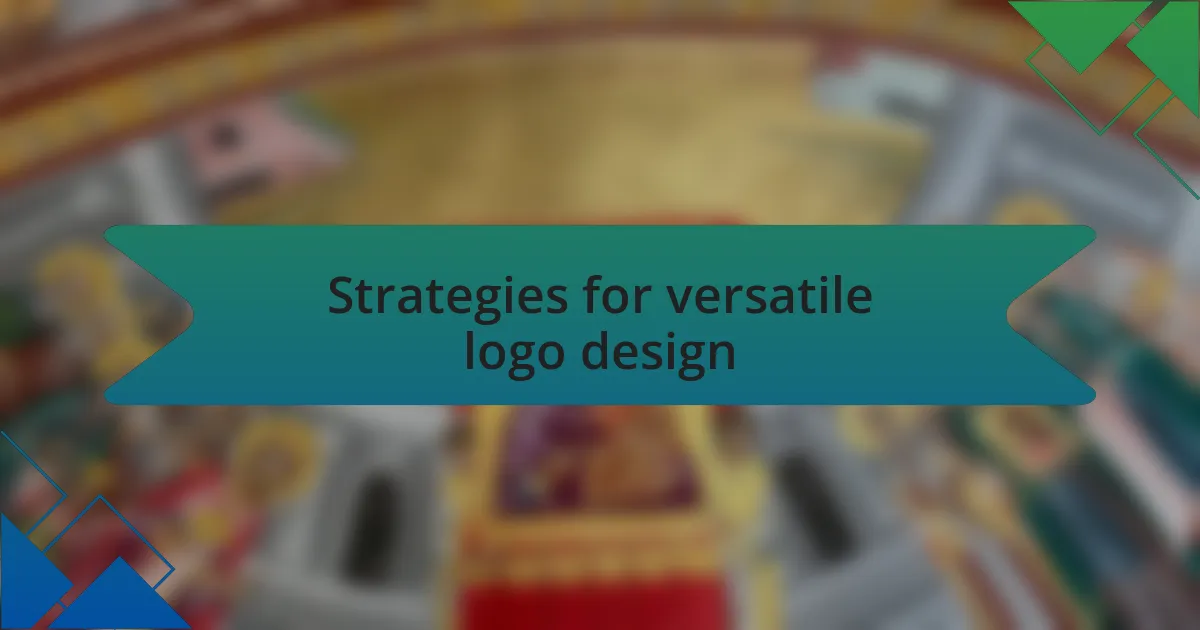Key takeaways:
- Logo versatility is essential for maintaining brand recognition and emotional connection across various platforms, enhancing consumer trust.
- Effective social media icons that are consistent and visually appealing can significantly influence brand visibility and consumer engagement.
- Simplicity, color contrast, and adaptability are crucial characteristics for creating effective logos and icons that perform well across different media.
- Design strategies, such as creating multiple logo variations and carefully selecting fonts, contribute to a logo’s versatility and effectiveness.

Understanding logo versatility
When I think about logo versatility, I often recall a time when I redesigned a brand’s logo for various platforms. It was fascinating to see how a simple tweak in color or size could change the entire look and feel of that brand online. Have you ever noticed how some logos look great on a website but fall flat on social media icons? That disparity really underscores the importance of adaptability.
A versatile logo can seamlessly transition across different mediums, from a large billboard to a tiny mobile screen. I remember working late nights adjusting a design to ensure it maintained its visual integrity, no matter where it appeared. It made me realize: if a logo can’t hold its own in various contexts, is it truly effective?
Moreover, the emotional connection we form with a brand often hinges on its logo’s versatility. Think about your favorite brands; don’t you appreciate how their logos remain recognizable, yet fresh across touchpoints? This adaptability not only enhances brand recognition but also deepens consumer trust. By ensuring a logo can shine in any setting, we create a stronger bond with the audience.

Importance of versatility in logos
A logo’s versatility is crucial because it ensures consistent brand recognition across various platforms and sizes. I remember one project where I used the same logo design for a mobile app and a desktop site, but I needed to tweak its proportions slightly. That experience taught me that even small adjustments can make a significant difference in how the logo is perceived across different user interfaces.
When I think about my own interactions with brands, I constantly reflect on how a logo can evoke feelings of familiarity and comfort, no matter where I see it. Have you ever instantly recognized a brand just by its logo, even if it was on a completely different platform? This emotional connection is enhanced when a logo adapts smoothly to each medium, fostering a deeper relationship between the brand and its audience.
Additionally, a versatile logo can save companies time and resources in the long run. I recall collaborating with a startup that initially had a rigid logo design. After redesigning it for versatility, they found that it not only reduced the need for continuous rebranding efforts but also increased their audience’s engagement. Isn’t it interesting how flexibility in design can lead to better customer interaction? Ultimately, a versatile logo is not just about aesthetics; it’s about creating enduring connections.
![]()
Role of social media icons
Social media icons play a vital role in enhancing brand visibility and accessibility. I once worked on a project where we designed custom social media icons for a local business. The feedback we received was overwhelmingly positive; people felt more drawn to the brand because the icons matched the overall identity. Have you ever noticed how a catchy icon can make you stop scrolling and take a second look? It’s incredible how these small images wield the power to influence consumer behavior.
Another aspect worth noting is the consistency that social media icons bring to a brand’s online presence. I vividly recall a client who had a mishmash of icons across platforms. It wasn’t just confusing; it made the brand seem unprofessional. Once we standardized their icons, not only did the aesthetic improve, but so did their followers’ trust in the brand. Isn’t it fascinating how something so seemingly small can alter perceptions so dramatically?
Moreover, social media icons serve as conduits for engagement. In my experience, when users see familiar icons, they’re more likely to connect with the brand on various platforms. I’ve seen users effortlessly transition from a company’s website to their social media pages just because the icons were clearly presented and recognizable. Do you find yourself more inclined to explore a brand’s content when their icons are eye-catching and cohesive? I know I do! This seamless connection significantly boosts interactions and followers, highlighting the importance of thoughtful icon design.
![]()
Key characteristics of effective icons
When I think about the key characteristics of effective icons, simplicity stands out as essential. One time, I was at a marketing conference where a speaker highlighted the importance of clean designs. It resonated with me because I’ve seen how overly complicated icons can confuse rather than attract. Have you ever tried to decipher an overly busy icon? It can be frustrating. Icons that are simple tend to communicate their purpose quickly, which is crucial in our fast-paced digital world.
Color and contrast also play a significant role in icon effectiveness. I remember working on a project where we experimented with different color palettes for social media icons. The moment we found the right contrast, it felt like things clicked into place. A well-chosen color palette not only enhances visibility but also evokes emotions. Isn’t it interesting how certain colors can make you feel excited or calm? Effective icons harness this power to draw users in and create an emotional connection.
Finally, adaptability is a vital characteristic that I can’t overlook. During a recent branding project, we needed icons that could easily be scaled down for mobile use yet still retain their clarity. I observed that versatile icons maintain their integrity across various sizes and backgrounds, making them more functional. Have you ever encountered an icon that looked fantastic on a desktop but fell flat on a smartphone? I certainly have, and it’s a stark reminder that a strong design must work seamlessly across all platforms.

Strategies for versatile logo design
When designing a versatile logo, one key strategy is to create multiple variations of the logo. In my experience, having a primary logo alongside simplified and monochrome versions can save the day in various applications. I recall a project where we had a main logo for web use, but when it came time to print on smaller merchandise, we needed a stripped-down version. Have you ever tried to fit a complex logo on a pen? It’s a tight squeeze! That’s why flexibility in design is essential.
Another strategy revolves around choosing fonts wisely. A memorable typeface can make or break a logo’s versatility. I once worked on a brand that seemingly had the perfect font, but it didn’t translate well to smaller screens. We ended up testing various fonts, and to my surprise, a more straightforward, sans-serif typeface outshone the more decorative one. Isn’t it fascinating how a simple change can enhance clarity and versatility across different formats?
Finally, always consider the surrounding context when designing a logo. One time, I was involved in creating icons for a new social media campaign, and we decided to test how the logo interacted with different backgrounds. It was eye-opening to see how mundane colors could transform a vibrant logo into something lifeless. Being mindful of context ensured the logo was not just a standalone piece, but a dynamic part of a larger visual story. What have you discovered about the power of context in visual design?

Lessons learned from personal experience
When I was developing a logo for a local coffee shop, I learned firsthand the importance of scalability. I initially designed an intricate logo that I thought captured the essence of the brand perfectly. However, during a focus group, the feedback revealed that when scaled down for business cards, the details got lost entirely. It was a humbling moment that taught me the significance of clarity at all sizes. Have you ever felt that frustration when something you loved just didn’t translate well?
Another lesson emerged during a project for a tech startup. I experimented with a vibrant color palette that seemed trendy at first. However, I quickly realized that the colors didn’t reproduce well on various media. After several reprints that failed to capture the intended vibrancy, I understood that color consistency is crucial for a logo’s versatility. How many times have you seen a logo that looked entirely different across platforms? It’s a stark reminder that what looks good on a screen might not always hold up in the real world.
Lastly, I recall working with a charity that aimed to inspire through their branding. We spent hours perfecting a logo that conveyed hope and community. The emotional connection we sought became clearer when we tested the logo with target audiences—what resonated deeply in one context fell flat in another. This experience emphasized to me that a logo must be versatile not only in form but in the emotional message it conveys. Have you ever considered how your logo speaks to different audiences?
![]()
Tips for improving icon versatility
When considering icon versatility, one of the first things I recommend is simplifying the design. I recall a client I worked with who wanted a logo that incorporated ten different elements. While it was visually striking in its full form, it became overwhelming when reduced to a tiny social media icon. Have you ever encountered a small icon that was just too cluttered? Stripping down to essential elements not only enhances recognition but also ensures that the icon maintains its impact at various sizes.
Color is another crucial aspect that deserves attention. In my experience, I’ve found that testing colors across different backgrounds and media can yield surprising results. One time, a vibrant logo I was proud of lost its essence when printed on a matte finish versus a glossy one. It made me realize that what looks appealing in a design software rarely translates perfectly in the real world. How do you ensure that your color choices remain effective across different applications? Creating a color guide for various uses can help maintain consistency and adaptability.
Lastly, don’t underestimate the power of context. I was once involved in a branding campaign for an eco-friendly product, and we needed to ensure that the logo could adapt to various marketing materials. Initially, the design was too focused on one specific campaign, but through discussions and testing, we reimagined it to reflect broader themes of sustainability. This adaptability made the logo resonate more deeply with audiences in various contexts. Have you thought about how your icon could convey different messages in different settings? Exploring these dimensions can significantly enhance its versatility.